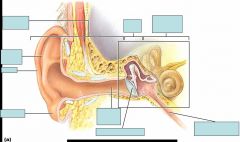![]()
![]()
![]()
Use LEFT and RIGHT arrow keys to navigate between flashcards;
Use UP and DOWN arrow keys to flip the card;
H to show hint;
A reads text to speech;
19 Cards in this Set
- Front
- Back
|
external jugular vein
|
located in the groove between the strenocephalicus m. and the braciocephalicus m.
Carries blood from the head running caudally to form the left and right brachiocephalic vein and then emptying into the cranial vena cava |
|
|
cephalic vein
|
after giving off the axillobrachial vein the cephalic vein goes deep to the brachiocephalicus m. and then empties into the external jugular vein
*important site for blood collection and IV placement |
|
|
cervical nerves
|
first cervical nerve exits the lateral vertebral foramen of the atlas. The successive nerves exit through the intervertebral foramina between adjacent vertebrae. The last one exits in between C7 and T1> (eight cervical nerves, only 7 cervical vertebrae
|
|
|
accessory nerve
|
the 11th cranial nerve
has motor function for the trapezius, sternocephalicus, cleidocephalicus, and onotransverasrius muscles |
|
|
common carotid artery
|
branches of the brachiocephalic trunk, to supply the head face and brain
|
|

vagosympathetic nerve trunk
|

the combined vagus and sympathetic trunk in the neck. Fibers of the vagus pass caudally while fibers of the sympathetic pass cranially. The fusion is broken at the thoracic inlet
|
|
|
carotid sheath
|
the sheath of connective tissue encasing the common carotid artery, the vagosympathetic trunk and the small internal jugular vein.
|
|
|
internal thoracic arteries
|
arteries running within the mediastinum on the dorsal surface of the sternum. Give rise to branches which run dorsally caudal to each rib
|
|
|
aorta
|
the great artery leaving the left ventricle and arching caudually. It sends oxygenated blood from the left heart to the heart itself and to the rest of the body
|
|
|
caudal vena cava
|
the large vein returning blood fromt the head neck and thorax limbs to the right atrium
|
|
|
caudal vena cava
|
the large vein returning blood from the thorax, viscera and the caudal body to the right atrium
|
|
|
phrenic nerve
|
arisis from the cervical plexus (joining of the fifth sixth and seventh cervical nerves) and supplies motor fibers to the diaphragm
|
|
|
vagus nerve
|
a mixed nerve-(motor and sensory function)
Motor: innervates the muscles to the parynx and larynx--controls swallowing and vocalization Sensory:sends fibers to the viscera of the cervical region, the thorax ans abdomen to regulate these oragans' activities |
|
|
left and right sublcavian veins
|
drain the thoracic limb and join the external jugular vein to form the brachiocephalic vein
|
|
|
azygos vein
|
recieves theintercostal veins from the level of the diaphragm to about the third or fourth intercostal space. Can drain into either the cranial vena cava or directly into the right atrium
|
|
|
left and right sublavian arteries
|
supply the ncek, thoracic limb, and the cranial portion oth the thoracic wall. Each has many branches
|
|
|
intercostal nerves
|
the ventral branches of the thoracic nerves, run ventrally caudal to each rib.
Supply the intercostal muscles and the overlying skin |
|
|
sympathetic trunk
|
located on either side of the thoracic vertebral column in the dorsal thoracic cavity
|
|
|
ramus communicans
|
the short communicating nerve that connects the dorsal branch of the thoracic nerves to the sympathetic trunk
|

